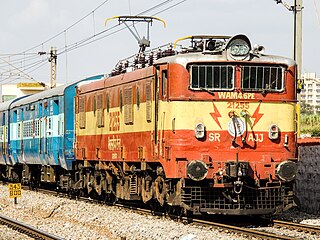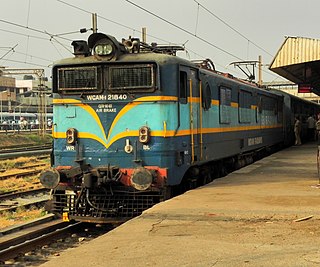Related Research Articles

The Indian locomotive class WDM-2 is a class of diesel–electric locomotive that was developed in 1962 by American Locomotive Company (ALCO) for Indian Railways. The model name stands for broad gauge (W), Diesel (D), Mixed traffic (M) engine, 2nd generation (2). They entered service in 1962. A total of more than 2,700 WDM-2 was built at ALCO and Banaras Locomotive Works, Varanasi between 1962 and 1998, which made them the most numerous class of mainline diesel locomotive until its successor the WDM-3A.

The Indian locomotive class WAM-4 is a class of 25 kV AC electric locomotives that was developed in 1970 by Chittaranjan Locomotive Works for Indian Railways. The model name stands for broad gauge (W), alternating current (A), mixed traffic (M) locomotive, 4th generation (4). They entered service in March 1971. A total of 500 WAM-4 were built at CLW between 1970 and 1983, which made them the most numerous class of mainline electric locomotive till its successor the WAG-5.

The NMBS/SNCB Class 77 is a class of 4 axle B'B' road switcher diesel hydraulic locomotive designed for shunting and freight work manufactured at the beginning of the 2000s by Vossloh Schienentechnik/Vossloh Locomotives at the Maschinenbau Kiel plant in Kiel, Germany for the National Railway Company of Belgium (SNCB/NMBS).

The Voith Gravita locomotives are a family of road switcher diesel-hydraulic locomotives built by Voith Turbo Lokomotivtechnik GmbH & Co. KG. Available in a range of configurations from 4 to 6 axles, they are designed for shunting and light and medium freight operations.

The Vossloh G1206 is a B'B' diesel hydraulic freight locomotive built in Kiel and used by several European railway operators including a SNCF specific variant the BB 461000 series.

The Vossloh G1700 BB is a four axle B′B′ medium power diesel-hydraulic locomotive manufactured by Vossloh Locomotives GmbH. in Kiel.

The Indian locomotive class WCAM-1 was a class of dual-voltage electric locomotives that was developed in 1973 by Chittaranjan Locomotive Works for Indian Railways. The model name stands for broad gauge (W), DC Current (C), AC Current (A), Mixed traffic (M) locomotive, 1st generation (1). They entered service in March 1973. A total of 53 WCAM-1 were built at CLW between 1973 and 1979, which made them the most numerous class of mainline dual-power AC-DC electric locomotive.

The Indian locomotive class WAP-1 was a class of 25 kV AC electric locomotives that was developed in 1980 by Chittaranjan Locomotive Works for Indian Railways. The model name stands for broad gauge (W), AC Current (A), Passenger traffic (P) locomotive, 1st generation (1). They entered service in late 1981. A total of 65 WAP-1 were built at CLW between 1980 and 1996, which made them the most numerous class of mainline electric passenger locomotive until its successor, the WAP-4.

The Indian locomotive class WDP-3A, colloquially nicknamed the Toaster, is a class of diesel–electric locomotive that was developed in 1998 by Banaras Locomotive Works, Varanasi for Indian Railways. The model name stands for broad gauge (W), Diesel (D), Passenger traffic (P) locomotive with 3,100 horsepower (3A). The WDP-3A is a later classification of earlier WDP-2. They entered service in 1998. A total of 44 were built between 1998 and 2001.

The Indian locomotive class WCG-2 is a class of 1.5 kV DC electric locomotives that was developed in the late 1960s by Research Design and Standards Organisation (RDSO) and Chittaranjan Locomotive Works (CLW) for Indian Railways. The model name stands for broad gauge (W), DC Current (C), Goods traffic (G) engine, 2nd generation (2). They entered service in February 1971. A total of 57 WCG-2 were built at CLW between 1978 and 1983, which made them the most numerous class of DC electric locomotive.

The Indian locomotive class WAM-1 was a class of 25 kV AC electric locomotives that was developed in the late 1950s by the Groupement 50Hz for Indian Railways. The model name stands for broad gauge (W), AC Current (A), Mixed traffic (M) locomotive, 1st generation (1). They entered service in 1960, thus making them the first AC electric locomotives to be in service in India. A total of 100 WAM-1s were built by the European consortium between 1959 and 1961, which made them the most numerous class of mainline electric locomotive until the WAG-1.

The WDS-4 is a class of diesel-hydraulic locomotive used by Indian Railways for shunting and departmental operations. The model name stands for broad gauge (W), Diesel (D), Shunting (S) engine. The WDS-4 was once used all over India but most have now been scrapped or condemned from active service.
The Indian locomotive class WDM-3 was a type of diesel-hydraulic locomotive that was developed by Henschel for Indian Railways in 1962. The model name "WDM-3" stood for broad gauge (W), Diesel (D), Mixed traffic (M) engine, 3rd generation (3). These locomotives were put into service between 1970 and 1971, and a total of eight were built between 1962 and 1970. However, they were decommissioned at Gooty in 1995 and are now retired from service.
The Indian locomotive class YDM-2 is a class of diesel-Hydraulic locomotive that was developed in 1986-90 by Chittaranjan Locomotive Works for Indian Railways. The model name stands for Metre gauge (Y), Diesel (D), Mixed traffic (M) engine, 2nd generation (2). They entered service in 1986. A total of 41 YDM-2 locomotives was built between 1986 and 1990.

The class WDS-5 is a diesel–electric locomotive used by Indian Railways for shunting and doing departmental works. The model name stands for broad gauge (W), Diesel (D), Shunting (S) engine. The WDS-6 is used all over India.

The class WDS-1 was a diesel-electric locomotive used by Indian Railways for shunting and carrying out departmental works. The model name stands for broad gauge (W), Diesel (D), Shunting (S) 1st generation (1). The WDS-1 is used mostly in the Northern Railway Zone (NR). All these locomotive s were withdrawn from service by the late 1990s.
The Indian locomotive class WDS-8 was a class of diesel–electric locomotive that was developed in 1979 by the Chittaranjan Locomotive Works for Indian Railways, but ended up being delivered exclusively to the private sector. The model name stands for broad gauge (W), Diesel (D), Shunter (S) engine, 8th generation (8). They entered service in 1979. A total of five WDS-8 locomotives was built at Chittaranjan Locomotive Works (CLW), Chittaranjan between 1979 and 1982.

The Indian locomotive class WAG-1 was a class of 25 kV AC electric locomotives that was imported from Europe in the 1960s for Indian Railways. The model name stands for broad gauge (W), AC Current (A), Goods traffic (G) locomotive, 1st generation (1). A total of 112 WAG-1 were built by The European Group 50 Hz Group/European Group/50 Cycles Group (consortium) between 1963 and 1966. They entered service in 1964.

The Indian locomotive class WAG-4 is a class of 25 kV AC electric locomotives that was manufactured by CLW in the late 1960s for Indian Railways. The model name stands for broad gauge (W), AC Current (A), Goods traffic (G) engine, 1st (1). A total of 186 WAG-4 locomotives were built by The European Group 50 Hz Group/European Group/50 Cycles Group (consortium) between 1967 and 1969. They entered service in 1967.

The Indian locomotive class ZDM-2 is a series of narrow gauge diesel-hydraulic locomotives built for Indian Railways by the German company Maschinenbau Kiel. In the 1980s and 1990s, several of the type were fitted with KPC engines, these were reclassified as the ZDM-2R.
References
Notes
- 1 2 "MaK - 650 C für die Indian Railways (IR)". loks-aus-kiel.de (in German). Lok-Datenbank.de. Retrieved December 10, 2023.
- 1 2 Anees Siddiqui (March 2014). "Application of hydraulic based transmission system in Indian locomotives- A Review". Government Industrial Training Institute. ResearchGate . Retrieved December 10, 2023.
- 1 2 "WDS-3". IRFCA.org. Retrieved December 10, 2023.
- ↑ "All Locos". IRFCA.org. Retrieved December 10, 2023.
Bibliography
- Hughes, Hugh (1996). Indian Locomotives: Part 4 – 1941–1990. Harrow, Middlesex: The Continental Railway Circle. ISBN 0-9521655-1-1. OCLC 35135033.



